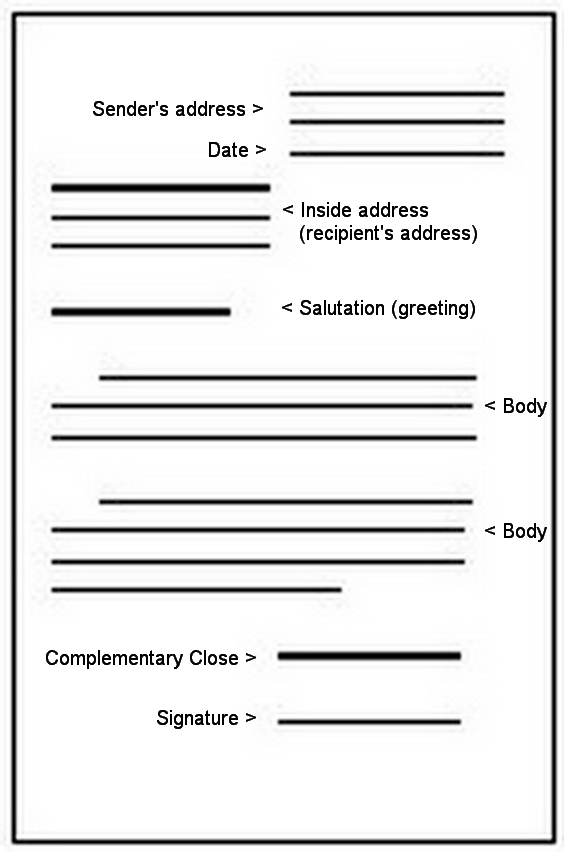Letters
PARTS OF THE FORMAL LETTER
The Heading (The Return Address) or Letterhead
- Your address should be displayed in the top right-hand section.
This will enable the person that you are writing to, to reply.
Companies usually use printed paper where heading or letterhead is
specially designed at the top of the sheet.
- It bears all the necessary
information about the organisation’s identity.
Date
- Date of writing.
The month should be fully spelled out and the year written with all
four digits October 12, 2009 or 12 October 2009 - UK style.
- The date is aligned with the return
address.
- The number of the date is pronounced as an ordinal figure,
though the endings -st, -nd, -rd, -th, are
often omitted in writing.
- The article before the number of the day is
pronounced but not written.
The Inside Address
- In a business or formal letter you should give the address of the
recipient after your own address.
- This address should be displayed beneath your address on the left-hand side,
remember to include the name of the person that you are writing to (if known).
- Include the recipient's name,
company, address and postal code.
- The number of the house is written before the name of the street
- Add job title if appropriate.
- Separate the recipient's name and title with a comma.
- Double check that
you have the correct spelling of the recipient 's name.
The Subject Line (optional)
-
It can help the recipient in dealing successfully with the
aims of your letter.
- Normally the subject sentence is preceded with the
word Subject: or Re:
The Greeting - also called the salutation.
- The type of salutation depends on your relationship with the recipient.
- It normally begins with the word "Dear" and always includes the person's last name.
- If you do not know the name or the sex of of your reciever address it
to Dear Madam/Sir (or Dear Sales Manager or Dear Human Resources
Director).
- In British English you can use comma (,) after the opening
and ending.When using comma then use it in both – opening and ending, if not, then also in both,
opening and ending.
The Body Paragraphs
- The body is where you explain why you’re writing.
- It’s the main part of the letter.
- Use a new paragraph when you wish to introduce a new idea or element into your letter.
- Make sure the receiver knows who you are and why you are writing but
try to avoid starting with "I".
The Complimentary Close
- This short, polite closing ends always with a comma when your greeting ends with a comma.
- It is either at the left margin or its left edge is in the center,
depending on the Letter Style that you use.
- It begins at the same column the heading does.
- The traditional rule of etiquette in Britain is that a formal letter starting with "Dear Sir or Madam" must end with
"Yours faithfully", while a letter starting with "Dear (name)" must end with "Yours sincerely".
Signature and Writer’s identification
- The signature is the last part of the letter.
- You should sign your first and last names.
- The signature line may include a second line for a title, if appropriate.
- The signature should start directly above the first letter of the
signature line in the space between the close and the signature line
Initials, Enclosures, Copies
- Initials are to be included if
someone other than the writer types the letter.
- If you include other
material in the letter, put 'Enclosure', 'Enc.', or ' Encs. ', as
appropriate, two lines below the last entry.
- cc means a copy or copies
are sent to someone else.
Compare British and American letters
| |
American Style
|
British Style
|
Heading
|
According to the format but
usually aligned to the left |
The heading is usually placed
in the top right corner of the letter
(sometimes centred) |
| Date |
October 19, 2005 (month-day-year)
According to the format but
usually aligned to the left
two lines below the heading. |
19 October 2005 (day-month-year)
Usually placed directly
(or 1 blank line)below the heading. |
| Salutation |
Dear Mr./Ms. Smith:
Dear Sir or Madam:
Gentlemen:
After the salutation there is a colon (:) |
Dear Mr./Ms. Smith,
Dear Sir or Madam,
Dear Sirs,
After the salutation there is a comma (,) |
| Complimentary close |
Sincerely,
Sincerely yours,
Yours truly, |
Sincerely,
Yours sincerely,
Yours faithfully, |
 Important Letters
Important Letters
1- Street Crimes / Law & Order Situation
2- Water Shortage for Irrigation / Agriculture Use
3- Un-hygienic Conditions / Provision of Civic Amenities
4- Traffic Problems / Rash Driving / Road Accidents
5- Misuse of Mobile Phones / Internet / Cyber Crimes
6- Power/Energy Crises / Load Shedding
7- Price Hike / Black Marketing
8- Urdu as Official Language
9- Terrorism / War on Terror
10. Hazards of Smoking / Drug Addiction
11. Importance of National Unity
12. Problem of Encroachment
13. Youth & Unemployment






